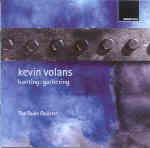If South African composer Kevin Volans’ name is familiar, it’s probably due to the tremendous success of the 1992 Kronos Quartet recording called Pieces of Africa, on which 1982’s White Man Sleeps, Volans’ first quartet, appears. It’s an appealing hybrid of African and European modalities, rhythms, and colors, presented as a series of dances that incorporates elements of Basotho, Nyungwe, and San music.
There are significant differences between the Duke Quartet’s interpretation and that earlier recording: the Duke players inject Volans’ music with a distinct and sharp emphasis on rhythm, which arguably is the first priority of sub-Saharan music. That character is immediately noticeable from the first of the quartet’s five dances, which the players urge on with a much greater sense of forward propulsion than achieved by the Kronos Quartet. That same emphasis emerges in the third dance, whose pizzicatos are modeled after animal gaits, and in the last movement, in which bowing accents zing like arrows through the score. By way of contrast, the second and fourth movements (which are based on the same material, inspired by Nyanga panpipe music) are a celebration of harmony, and the Duke’s relaxed, expansive style makes the unusual sonorities glow. While the Kronos’ version might be the benchmark due to its long-term, high-profile association with this piece, the Duke’s fresh, bold reading is a very welcome addition.
1987’s Hunting: Gathering (Volans’ second quartet) is something of a continuation of his first foray. Again, we hear an emphasis on rhythm as well as material based on African traditional music (from the Hamar people of south Ethiopia and Zimbabwean mbira thumb-piano music from the Shona heritage, among other sources). But unlike the dance-suite format of the earlier work, this quartet has a fragmented quality that evokes the disoriented, scattered feeling of images from a barely remembered dream. Here again, the Duke players’ attention to crisp detail makes the work really sing out, especially in the first movement where the forceful voice of violist John Metcalfe takes the lead and the other players gently respond to his confident overtures.
Ironically, in light of his earlier successes, Volans has completely rejected his previous “fusion” attempts as artifacts of a specific place and time: “To me,” he explains, “the moment for this kind of work has passed, along with the apartheid State.” 2000’s String Quartet No. 6 evidences that change in approach: here, Volans attempts to echo the starkness and stillness of a blank white canvas (“eliminating subject matter in my music as far as possible”). The piece, which actually is for quartet and tape or two string quartets, is a nearly half-hour-long meditation on slowly sounded chords. Particularly in this work listeners will appreciate the disc’s rich, full sound, which accentuates the music’s near-hypnotic effect.
































